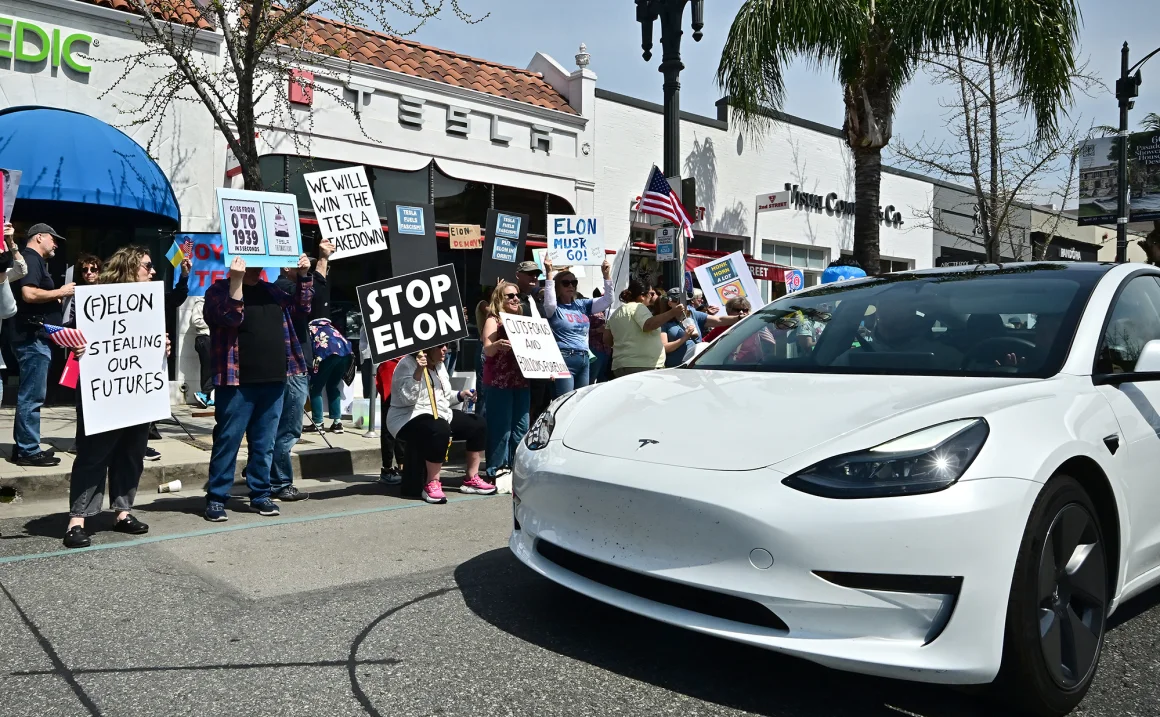Things are undeniably rough at Tesla. Sales are shrinking. Profits are plunging. The stock price is in a free fall. Protests outside Tesla showrooms have become a regular scene. The much-hyped Cybertruck has failed to impress. And somehow, the situation is even worse than it seems.
Tesla just reported a staggering 71% drop in net income, a number that might have been overlooked amid CEO Elon Musk’s announcement that he would step back from his controversial role at the Department of Government Efficiency (DOGE). But that financial blow is a glaring signal of deeper troubles, driven by declining sales for the first time in Tesla’s history and falling EV prices globally.
At the core of Tesla’s problems is a collapsing bottom line. A closer inspection of its first-quarter earnings reveals an alarming fact: Tesla is losing money on its main business — selling cars.
The company scraped together a $409 million profit only because it sold $595 million worth of regulatory credits to other automakers. Without these credits, Tesla would have been deep in the red. Worse yet, if the Trump administration eliminates the federal regulations that fuel the demand for these credits, Tesla could lose this vital revenue stream too.
Falling Sales and Rising Challenges
Tesla’s sales are faltering under pressure from growing competition, especially in China where rivals like BYD are surging ahead. The company is losing ground not just in China, but also in Europe — even as overall EV sales rise in both markets. Tesla is on the verge of losing its crown as the world’s largest EV seller to BYD.
Compounding the situation is Musk’s increasingly polarizing political involvement. His support for far-right parties, such as Germany’s AfD, and efforts to dismantle government agencies have alienated a section of Tesla’s traditional customer base. Even some of Musk’s most loyal supporters on Wall Street admit that the damage to Tesla’s brand could be lasting, despite his promises to step back from politics.
Musk, however, downplayed the crisis, telling investors, “We’re not on the ragged edge of death, not even close.” He acknowledged some challenges ahead but remained “extremely optimistic” about Tesla’s future.
Still, he avoided addressing one major threat: the Trump administration’s efforts to scrap tough federal and state emissions rules, which have historically provided Tesla with billions in revenue from regulatory credits.
Since 2021, Tesla has earned a whopping $8.4 billion from these credits — a significant cushion that kept it afloat while it built its business. Losing that financial crutch could expose the company’s underlying weaknesses further.
Margins Shrink to Prehistoric Levels
Another red flag: Tesla’s once-industry-leading profit margins are shrinking fast. The company’s gross automotive profit margin, excluding regulatory credits and other costs, fell to just 12.5% in the first quarter — a dramatic decline from the 30% margin Tesla posted in early 2022.
According to Morgan Stanley, Tesla hasn’t seen margins this low since 2012, back when it was a fledgling company selling just 5,600 cars a year. By comparison, Tesla sold almost that many cars daily in 2023.
At its 2022 peak, Tesla was the most profitable carmaker in America, despite selling far fewer vehicles than giants like GM and Ford. Those high margins, combined with aggressive sales growth, sent Tesla’s stock price soaring, making it the world’s most valuable car company — and Musk the richest man alive.
But that momentum has now reversed. Last year marked Tesla’s first annual sales decline, driven both by fierce competition and public backlash against Musk’s controversial political stances.
The Robotaxi Gamble
Despite these setbacks, some investors remain hopeful — largely because of Tesla’s ambitious plans for robotaxis and humanoid robots. Musk claims that these innovations could eventually make Tesla more valuable than the next five most valuable companies combined.
Tesla plans to debut its first robotaxi service in Austin, Texas soon. And Musk also predicts humanoid robots will start working in Tesla factories later this year.
Some, like Gene Munster of Deepwater Asset Management, see 2025 as a “setup year” that could lead to stronger performance ahead, with Tesla poised to grab a big share of the ride-hailing market.
However, competitors tell a different story. General Motors has already abandoned its robotaxi project after deeming it financially unfeasible. Ford, too, has pulled back on its autonomous vehicle efforts, citing profitability concerns.
Ford CEO Jim Farley summed it up bluntly: “Profitable, fully autonomous vehicles at scale are a long way off.”
Even Musk has repeatedly overpromised and underdelivered on self-driving technology. He famously admitted, “I’m the boy who cried FSD,” referring to Tesla’s much-delayed “Full Self-Driving” feature.
Although the U.S. Department of Transportation’s new automated vehicle framework — aimed at easing regulatory barriers — gave Tesla’s stock a temporary boost, there’s no guarantee the robotaxi dream will materialize anytime soon.
The Road Ahead
Tesla’s problems are piling up: shrinking profits, shrinking margins, shrinking sales, and a battered brand image. Musk remains defiant, and some investors are still betting on Tesla’s bold future.
But for now, the electric car pioneer that once raced ahead of its competitors finds itself stuck — and the road to recovery looks anything but smooth.



Leave a Reply